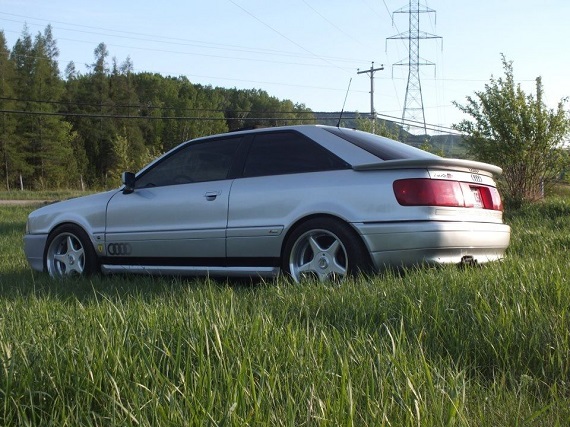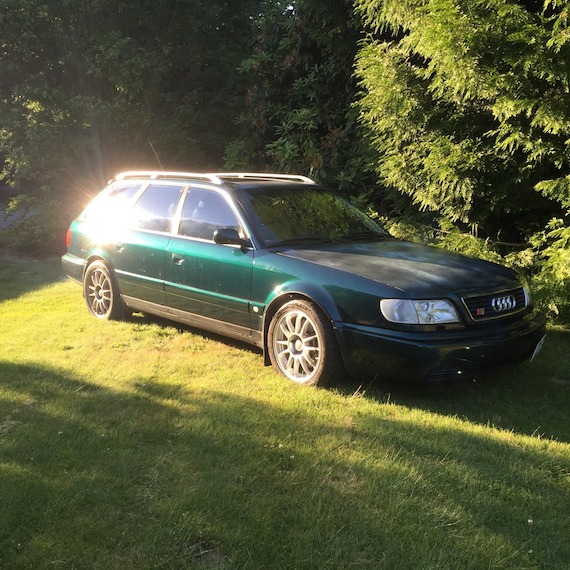The excellent line of C4 Audis I’ve had the pleasure of writing up continues today! If you recall my last post about the 1995.5 S6 Avant, you’ll remember that I spoke about these cars having a bespoke feel. Here’s a great example of what I meant; what we have is a very desirable 1995 S6 Avant. Unlike the 1995.5, the 1995 model got the updates of the S4 to S6 like the bumpers, but retained the early driver-actuated differential lock rather than the ABS-system reliant electronic differential lock. But some of the differences were more subtle than just that; there were changes to the headrests, for example, though the Avants early on kept the open center headrests rather than the solid units found in later sedans and Avants. You’ll note, if you look carefully, that the 1995.5 in our other featured listing had the solid headrests. That would place this as an early 1995 S6, but some of the early cars carried over the forged Fuchs wheels associated with the S4, this car has the later Speedline-made Avus wheels in place. You’ll also note, again if you look carefully, that the early 1995 S6s retained the infrared central locking system (denoted by a button on the B-pillar) – a system later replaced by the radio frequency system found on newer models. Sure, these are all small items, but they’re interesting tidbits that once again make nearly each Avant a unique car – few are identical. This particular car was also specified in the classic color combination of double black; a classic color combination which gives this lovely example a sinister and standout presence:
Tag: AAN
For some time, if you wanted to go fast in a two-door Audi in the U.S., you had to make your own car from pieces of others. Even if you selected the much praised Quattro, you had a fairly heavy car to start with that was coupled to a rather measly 160 horsepower. Unless it’s snowing, a bone stock Ford Fiesta ST will pretty thoroughly stomp all over the legendary boxflared wonder in just about every situation. So people began modifying the turbocharged cars to produce more boost and bring them into line with their European counterparts. Of course, when it came to the replacement for the Quattro, those that waited longingly from 1985 until 1989 for the next turbocharged coupe were greatly disappointed. Sure, the new 90-based B3 Coupe Quattro had 20 valves under the hood – but no turbo came here. Europeans enjoyed several iterations of the turbocharged B3 and B4, including the Porsche tuned RS2, but in North America only the normally aspirated, slightly portly 2-door hatch came here. Again, it was no surprise that as soon as they were outside of warranty, people began to tinker; in this case, making their own S2s out of pieces from their bigger brother 200/S4s. Installing the 20V Turbo into the engine bay instantly transformed the Coupe Quattro from competent cruiser to sleeper assassin:
CLICK FOR DETAILS: 1990 Audi Coupe Quattro on eBay
Comments closedIn yesterday’s S4 post, I covered many of the special items that made the ’92 model unique for the U.S. market; in fact, I said that in many ways it was the most highly sought of the C4 models. Well, that probably was a bit of overstatement in at least one regard, because while it may be true for sedans for many the Avant model from 1995 was much more special. 1994 to 1995 saw some major changes for the C4; the most obvious being the model designation change from S4 (1991-1994) to S6 (1995-1997). European models had some additional drivetrain options that weren’t available in the U.S., and indeed the Avant had previously been available in S4 form, but the 2.2 liter turbocharged inline-5 carried over largely unchanged into 1995. The big news was the addition of the Avant to the U.S. lineup; at the time, as expensive as an Audi got here. There was also the obvious external refresh; smooth body-colored bumpers and wider side trims eliminated the rubberized black moldings. The hood and lights were lightly re-sculpted too, along with the change (rolling, for some models) from the Fuchs-made 5-spoke alloys to the Speedline-made 6-spoke Avus wheels which would be the signature S-wheel for the next decade. Gone were two staples of the Audi lineup from the 1980s – Procon 10, the seatbelt pre-tensioning safety system Audi highly marketed in the late 1990s disappeared with little fanfare, but also, perhaps more strikingly, S cars would no longer be branded with “quattro” badges – a change that would carry on nearly until today’s models, where models like the RS7 re-introduced it in the grill. Inside minor changes were introduced; a revised dashboard, shift knob, along with the introduction of the most notable change (once again, rolling) to a 3-spoke sport steering wheel. It was a tremendous amount of minor changes that in sum resulted in a slightly different feel for the S6; slightly more polished and grown up, carrying the new design language for Audi that would remain for the next decade. Audi wasn’t done, though, because in “1995.5” Audi once again changed several items on the then-still-new S6. This included a major change moving forward – the elimination of driver control of the rear differential, a hallmark of Audis since the introduction of the original Quattro. Audi opted for an “electronic differential lock”, which in reality was a system which utilized the ABS system to detect wheelspin and apply the brakes. This major change resulted in some minor interior tweaks, such as moving the cigarette lighter, and there were additional revisions to the radio. The transmission’s traditional weak first gear was also addressed, as well as adding infrared locking and some other minor trim changes. All of these changes – some of them running changes – give the limited production S6s, and especially the Avants, a bit of a bespoke feel. With numbers produced only in the hundreds, these are special and coveted cars that are very capable – and highly sought:
CLICK FOR DETAILS: 1995.5 Audi S6 Avant on QuattroWorld
Comments closedThe Audi C4 platform has been a perennial favorite tuning platform; just the other day in my Facebook feed a quick video popped up of an original S4 putting out over 1,000 horsepower at a staggering 11,000 RPM on a dyno. If that alone doesn’t tell you a bit about the stoutness of the turbocharged 5-cylinder mill, then perhaps the multitude of 400+ horsepower examples burbling happily along would. At their right foot the owners hold back a soundtrack of 5 barking cylinders which produce tunes that sound roughly like Pavarotti was being squeezed to death by Zeus, replete with lightning bolt cracks and flashes of fire in the sky with every shift. But properly building an AAN or other turbocharged 5-cylinder to handle really heavily increased boost will quickly double the purchase price of your budget S4/S6. So, is it a better proposition to buy one that’s done?







